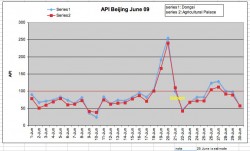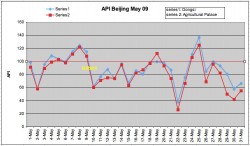Now more info available, see the Page “Beijing Pollution API intro”!
Including on the measuring station the city now hates… Of a country that on their national day said:
– 4 July at 19:00 AQI was 261 and at 24:00 was 231. Very unhealthy.
While the BEPB station close by had the following API:
– Period ending at 12:00 on 4 July: 104 (unhealthy for sensitive groups)
– Period ending at 12:00 on 5 July: 117 (unhealthy for sensitive groups)
Now we all know they measure different things but have a look outside of your window and see for yourself.
Pollution
Official API figures for June 2009
Here it is, my table for June 2009. Only one date I missed. Again, the same two locations.
Interesting is to note that the 2nd location, Agricultural Palace, is pretty close to the U.S. Embassy who has now its own monitoring station with a focus on PM2.5. So, the argument of China Daily and other Chinese “specialists” that the Embassy’s reading is in a (more) polluted zone being CBD does not make any sense. As one can see in my table, Dongsi is overall worse and there are still worse locations. Also, “CBD”? grab a map folks. CBD is several subway stations to the south!
More about the Embassy readings later (available on Twitter only). Yes, PM2.5 is very bad and my lungs are full with it. Our Chinese goons here don’t like it at all that the Embassy and others indicate how bad Beijing really is. Promptly all website links reporting on the bad air are blocked. Call it “Green Dam”. Keep the citizens in the dark.
Even when Beijing says the air is “good”, you better stay inside, switch on a good air filtering machine and refrain from heavy exercise.
Just an illustration: in the night pollution is generally bad as the trucks run (wildly) around. On 2 June 23:00 Embassy reports EPA AQI (Environmental Protection Agency Air Quality Index) of 157 “unhealthy”. Average of the day: 141 (unhealthy for sensitive groups). Compare that to Beijing official figure of API 56. The periods do not correspond completely but the difference is too large.
More to come, check the Pages on the right.
CAPEC Conference 19 June
CAPEC is the abbreviation of China Association of Plant Engineering Consultants. Affiliated to General Administration of Quality Supervision, Inspection and Quarantine (AQSIQ), it is a national-level nonprofit professional intermediary organization in Chinese plant engineering industry. CAPEC is organized by representatives from such units and social entities as plant engineering consulting, design, manufacturing and users, as well as volunteers related to plant engineering activities. CAPEC is committed to promoting the plant engineering consulting system in China, and standardizing the plant engineering activities through the supervision and management over the process of design, manufacture and installation of important plants in construction projects, so as to ensure the quality and investment benefits of the plants, guarantee the important projects to be implemented smoothly and promote China’s plant engineering consulting industry to keep pace with that of developed countries earlier.
CAPEC organized the “International Forum on Plant Engineering Consulting Cooperation 2009, held in Beijing International Hotel on 19 and 20 June 2009. The Vice Minister of AQSIQ, the former Vice Mayor of Beijing and other personalities attended, along with embassy representatives from the UK, Finland, Spain and others.
The theme: “Quality Safety & Sustainable Development”.
On 19 June, as Chair of the Public Procurement Working Group of the European Chamber (EUCCC), Gilbert gave a presentation on the EUCCC, the Working Group and one of its key recommendations:
Utilize Green Public Procurement (GPP) and Life Cycle Cost (LCC):
– Promote public procurement policies that encourage the development and diffusion of environmentally friendly goods, construction works and services.
– Allow for environmental considerations and higher quality solutions in technical specifications, selection and award criteria, and contract performance clauses.
– Include LCC as an award criterion to identify the most economically advantageous tenders.
Gilbert illustrated some of the issues by showing examples of poor construction, leading to excessive waste, high maintenance costs and poor use of water and electric power. One of the (poor) examples was Julong Garden… Chinese construction and maintenance “Chinese style”.
Pictured is Mr. Ben Papé, Chairman, The Institution of Engineering and Technology, BETNET.
Ben also happens to be the Advisory Counselor of the China Children and Teenagers’ Fund – one of the partners of the Rotary Club of Beijing.
Beijing API May 09
The table for May 2009 is done! Shows the pollution in Beijing.
I now included a second measuring point, the Agricultural Exhibition Palace.
For further details, see the related Pages in the right hand column of this blog – more general information on API, pollution effects, charts etc. All completely re-designed!
Beijing Pollution Data: finally!
Further to my earlier entry I finally took the time to table at least the results for the first 4 months of 2009. So, no more guessing – these are the official figures from the Beijing Environmental Protection Bureau. The API refer to one measuring point (exact location unknown) – Dongsi in Dongcheng District, Beijing. It is supposed to be not too far from where I live (Gongti Xi Lu).
The data normally refer to a 24 hour average from 12 noon – 12 noon on the mentioned date.
One can argue about the accuracy and the fact it is a 24 hour average. But this is what we got.
Those data you cannot find anywhere as the Bureau promptly removes them after one day, so the tables are unique!
- click to enlarge
- click to enlarge
- click to enlarge
I have the data now for nearly a full year.
Dongsi is not the best but also not the worst location.
In the past “Qianmen” was always by far the worst but it was simply dropped from the list – no explanation needed here!


















